
Braised lion’s head, it’s like an irresistible culinary extravaganza. With a crispy exterior and an incredibly tender meat inside, lion’s head offers a rich texture and unique flavor that is unforgettable. In the flavorful gravy, the lion’s head shines like a delicious gem, enticing and tempting. Each bite brings satisfaction and happiness, as if transported back to childhood food memories. This braised lion’s head is like a delightful ode, singing the charm of Huaiyang cuisine.
Ingredients for Braised lion’s head:
| Pork | 500g |
| Shiitake mushroom | 50g |
| Water Chestnut | 50g |
| Scallion | 10g |
| Ginger | 15g |
| Salt | 5g |
| Oyster sauce | 10g |
| Dark soy sauce | 4g |
| Cooking wine | 10g |
| Chopped green onion | 5g |
| Egg | 50g |
| Starch | 6g |
| Green onion | 5g |
| Light soy sauce | 10g |
| Sugar | 3g |
| Firm tofu | 50g |
| Pepper powder | 4g |
| Small chili pepper | 3g |
Step:
1.Select approximately 500 grams of pork with alternating layers of fat and lean meat. Start by slicing it into thin, even pieces, and then chop it into medium-sized minced meat. It’s important not to chop the meat too finely, as this could affect the texture and mouthfeel of the final dish. Maintaining a certain graininess in the minced meat will give the lion’s head a more chewy and satisfying texture.
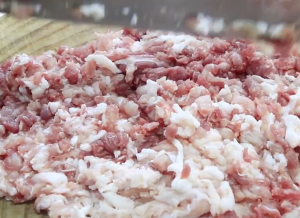
2.In addition to preparing the pork, we also need 4 dried shiitake mushrooms. Begin by cutting off the mushroom stems and thoroughly washing them in clean water. After washing, remove the mushrooms from the water and gently squeeze out any excess moisture. Next, slice the mushrooms into thin pieces and then dice them into small cubes for later use. Adding shiitake mushrooms helps enhance the natural umami flavor of the lion’s head dish. Shiitake mushrooms have a unique aroma and texture that enriches the overall layers of taste and flavor.
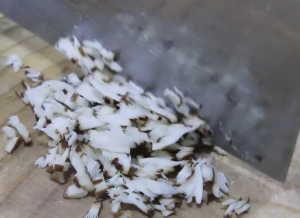
3.When making lion’s head, besides having the prepared pork and shiitake mushrooms, we can also add some peeled water chestnuts to enhance the texture and flavor. Peel a few water chestnuts and cut them into small cubes. Water chestnuts provide a crisp and refreshing element with a sweet taste and juicy texture. Incorporating them into the lion’s head not only adds to the dish’s texture but also imparts a distinct aroma and taste. The addition of water chestnuts makes the lion’s head more diverse and delectable, enhancing the overall appeal of the dish.
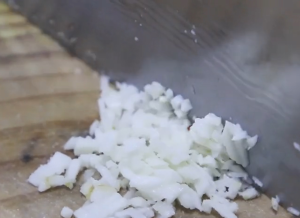
4.To increase the tenderness of the meatballs, we can also add a piece of pressed tofu when making lion’s head. First, crush the pressed tofu with a knife and then cut it into small cubes for later use. Pressed tofu offers a delicate texture and rich soybean aroma, making the meatballs juicier and more tender. The moisture from the tofu provides additional moistness to the meatballs, enhancing their softness. Additionally, tofu can absorb the flavors from the braising liquid, resulting in a more flavorful meatball. By adding finely chopped pressed tofu, the lion’s head dish becomes more diverse and delicious. It not only improves the tenderness of the meatballs but also brings a unique texture and soybean flavor.
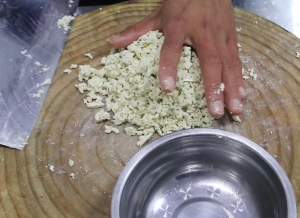
5.Before making lion’s head, prepare some additional seasoning spices. Take 3 small spring onions and gently crush them to release more fragrance. Additionally, slice a piece of ginger and place it in a bowl with the spring onions. Add an appropriate amount of water to the bowl and let the spring onions and ginger soak for about 10 minutes. This allows the flavors of the spring onions and ginger to dissolve into the water, providing a richer aroma for the seasoning sauce of the lion’s head.
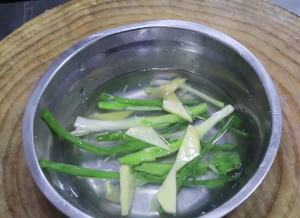
6.Next, we will season the filling. Start by adding 3 grams of salt and 2 grams of black pepper powder for seasoning. Then, add 5 grams of oyster sauce for umami flavor, 2 grams of dark soy sauce for color, and 5 grams of cooking wine to remove any undesirable odors. After adding these seasonings to the bowl, stir well to thoroughly blend them with the minced meat. Gradually add a small amount of the spring onion and ginger water while continuing to stir, pouring it into the seasoned minced meat. Stir vigorously in one direction to allow the minced meat to absorb the moisture and seasonings, enhancing the texture. This stirring process should continue for about 5 minutes, and you can add another round of spring onion and ginger water during this time. Through stirring, the minced meat becomes more sticky and elastic, resulting in a chewier texture for the lion’s head. These steps ensure that the seasonings are evenly mixed with the minced meat, and the meat absorbs the moisture and seasonings fully. The resulting lion’s head will be more flavorful and delicious.
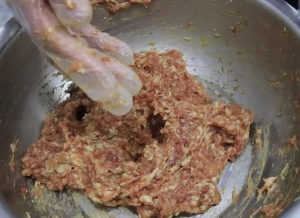
7.Next, we will add the prepared diced ingredients and continue stirring vigorously. During the stirring process, we need to add one egg and a small handful of cornstarch. Make sure to stir quickly in the same direction. Adding an egg makes the minced meat smoother and tenderer. The egg adds richness to the meatballs, making them more textured and tender. The addition of cornstarch is to increase the stickiness, allowing the meatballs to maintain their shape without breaking apart. While stirring vigorously in the same direction, use force to beat the minced meat until it becomes firm and elastic. This stirring process should continue for about 10 minutes to ensure that the seasonings and additional ingredients are fully integrated, and the minced meat reaches the desired texture and mouthfeel. Through these steps, we can create lion’s head with a delicate, smooth, and elastic texture.
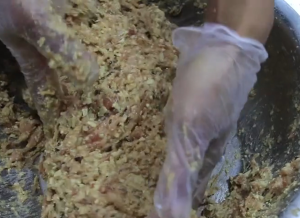
8.Next, we prepare to deep-fry the lion’s head. First, pour cooking oil into a pot and heat it up to around 60% hot, indicated by slight smoke rising from the oil surface. Take the prepared filling and shape it into evenly sized meatballs. Place the meatballs into the pot one by one. Note that once the meatballs are in the pot, reduce the heat to low. This ensures that the meatballs are not cooked through too quickly, allowing the inside to fully cook while frying. Continue cooking on low heat for about 3 minutes. This time will ensure that the inside of the lion’s head is fully cooked while maintaining a soft texture. After frying for 3 minutes, observe that the surface of the meatballs turns slightly golden and then remove them from the oil.
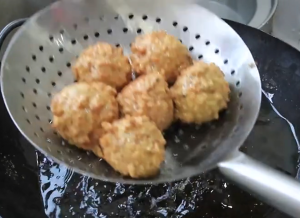
9.Now, we can perform a second round of frying to make the meatballs even crispier. Raise the oil temperature to around 60% hot again. Pour all the previously fried meatballs back into the pot and fry them for an additional 30 seconds. The second frying will give the lion’s head a golden and crispy exterior while keeping the inside tender and juicy. The second frying process only takes a short time, approximately 30 seconds. Make sure to control the heat properly to avoid overcooking, which could result in the meatballs becoming too dry. After the second frying, the lion’s head will have an appealing golden color with a crispy exterior and tender interior.
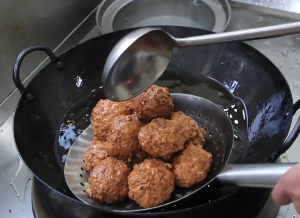
10.After frying the lion’s head, we can prepare some garnishes to enhance the aroma and flavor. First, take a piece of ginger and crush it with a knife before cutting it into small pieces. Next, split a section of a spring onion lengthwise in the middle and then slice it into small pieces. In addition, cut 3 small chili peppers into rings. Mix the chopped ginger, spring onion, and chili peppers together. This combination adds a spicy and refreshing flavor to the lion’s head. The ginger brings a spicy aroma, while the spring onion provides a fresh taste, and the chili peppers add a hint of spiciness to the dish. These garnishes will make the lion’s head even more delicious.
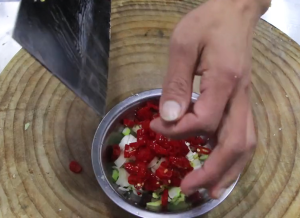
11.In the pot, leave some oil and heat it up. Once the oil is hot, add the previously prepared spring onion, ginger, and chili pepper into the pot and quickly stir-fry to release their aromatic and spicy flavors. You can drizzle some water along the edge of the pot and then bring it to a boil over high heat. Once the water boils, we can start preparing the sauce for the lion’s head. Add 2 grams of dark soy sauce for color, 5 grams of cooking wine to remove any undesirable odors, 2 grams of salt for seasoning, 2 grams of black pepper powder, and a little bit of sugar for taste. Finally, add 10 grams of light soy sauce and stir well to evenly distribute the seasonings. These seasonings will bring a rich and flavorful taste to the lion’s head.
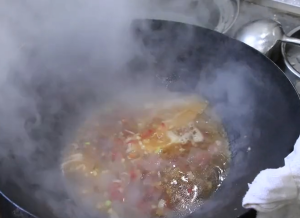
12.Once the sauce is brought to a boil, pour the previously fried meatballs into the pot, making sure all the meatballs are completely submerged in the sauce. Then cover the pot, reduce the heat to low, and continue simmering for 10 minutes. The purpose of this step is to allow the lion’s head to fully absorb the flavors of the sauce, making it more flavorful and aromatic. Through the simmering process, the meat inside the meatballs will also become tender and juicy. During simmering, remember to keep the heat low to avoid overcooking or sticking to the bottom of the pot. After 10 minutes, you can open the lid and enjoy the rich sauce and delicious lion’s head. The cooked lion’s head will have a golden, crispy exterior and a soft, juicy interior, infused with the flavors of the sauce, creating an irresistible aroma.
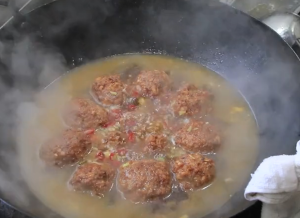
13.After simmering for 10 minutes, the lion’s head is fully cooked and well-seasoned. Now, using a slotted spoon or chopsticks, remove the meatballs from the pot and arrange them on a plate. Ensure that the meatballs are neatly arranged, creating an attractive presentation. This will increase the appetite and make the dish more enticing. Finally, pour the sauce from the pot evenly over the meatballs. This way, the meatballs will absorb the aroma and flavor of the sauce, adding even more richness to the dish. Now, this delicious lion’s head is ready to be served! Bring the fragrant plate to the table and enjoy this beautifully flavored lion’s head with family and friends.
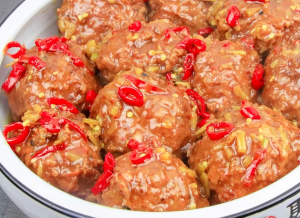
Tips:
1.To make lion’s head, it is best to use minced pork, preferably a combination of lean and fatty pork belly, which will help maintain a tender and juicy texture.
2.When frying the meatballs, start with a higher oil temperature. The high temperature helps the meatballs to quickly form a shape. Once the meatballs are added, reduce the heat to avoid burning the exterior while leaving the inside undercooked.
3.Before heating the oil, lightly pat the prepared lion’s head with your hands. This will help them become more compact and less likely to fall apart during frying.
4.During the frying process, maintain a moderate oil temperature and slowly place the lion’s head into the hot oil until they turn golden brown. This ensures a crispy exterior while ensuring the inside is fully cooked.
Braised lion’s head consists of pearl-like meatballs floating in a rich red sauce, exuding an enticing aroma. Each meatball is like a small universe, filled with flavorful yet not greasy meat and delicate tofu paste, creating a perfect combination of texture and taste. The braising cooking method allows the lion’s head to absorb even more flavor, blending the deliciousness of the meat with the richness of the spices, making it irresistible.

